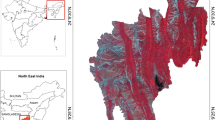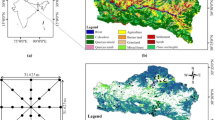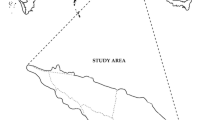Abstract
Forests play a critical role in ecological functioning, global warming and climate change through its unique potential to capture and hold carbon (C). Biomass is one of the indicator of the status of forests hence accurate assessment and biomass mapping is important for sustainable forest management. The objectives of this study is to estimate above ground biomass (AGB) from field inventory data and to map AGB combining field inventory data, remote sensing and geo-statistical model. In the present study stratified random sampling were used for estimation of biomass in which 59 plots were laid down in different homogenous strata depending on the NDVI values for the region of Maharashtra Western Ghats. The above ground biomass from field ranged from 0.05 to 271 t-dry wt ha−1 in which trees added maximum towards total biomass followed by shrubs and herbs. This paper evaluates the best vegetation indices to estimate biomass. This study was carried out by using Landsat TM satellite data and field inventory data in the Ratnagiri district of Maharashtra, India. A significant correlation was observed between biomass and vegetation indices. The best fit regression equation developed from field above ground biomass and NDVI with R2 value of 0.61 was used for spectral modeling to estimate the geospatial distribution of AGB in the entire region. The results of spatial predictions Geostatistical technique and remotely sensed data as auxiliary variables were compared using statistical error methods. This study employed Mean error, Root-Mean-Square error, Average Standard error and Root-Mean Square Standardized error. The ME, RMSE, Average Standard error and Root-Mean Square Standardized error was 0.078, 8.032, 7.982 and 0.967 respectively. The results showed that cokriging technique is one of the geostatistical method for spatial predictions of biomass in the studied region. The present study revealed that remote sensing technique combined with field sampling provides quick and reliable estimates of above ground biomass and carbon pool and can be used as baseline information for further temporal studies of biomass status of the region and in planning of forest and natural resources management.








Similar content being viewed by others
References
Akhavan, R., & Kia-Daliri, H. (2010). Spatial variability and estimation of tree attributes in a plantation forest in the Caspian region of Iran using geostatistical analysis Caspian. Journal of Environmental Sciences, 8, 163–172.
ANSAB, (2010). Forest Carbon Stock Measurement (1st ed.). Kathmandu, Nepal: ANSAB, FECOFUN, ICIMOD.
Berterretche, M., Hudak, A. T., Cohen, W. B., Maiersperger, T. K., Gower, S. T., & Dungan, J. (2005). Comparison of regression and geostatistical methods for mapping Leaf Area Index (LAI) with Landsat ETM + data over a boreal forest. Remote Sensing of Environment, 96(1), 49–61.
Borah, N., Nath, A. J., & Das, K. A. (2013). Aboveground Biomass and Carbon Stocks of Tree Species in Tropical Forests of Cachar District, Assam, Northeast India. International Journal of Ecology and Environmental Sciences, 39(2), 97–106.
Brown, S. (2002). Measuring carbon in forests: current status and future challenges. Environmental Pollution, 116(3), 363–372.
Burrough, P. A. (1986). Principles of geographical Information Systems for land resource assessment, Monographs on soil and resources survey, Number 12. Oxford, UK: Oxford Science.
Cerbu, G. A., Swallow, B. M., & Thompson, D. Y. (2011). Locating REDD: A global survey and analysis of REDD readiness and demonstration activities. Environmental Science & Policy, 14(2), 168–180.
Chen, J. (1996). Evaluation of vegetation indices and modified simple ratio for boreal applications. Canadian Journal of Remote Sensing, 22, 229–242.
Chirici, G., Barbati, A., & Maselli, F. (2007). Modeling of Italian forest net primary productivity by the integration of remotely sensed and GIS data. Forest Ecology and Management, 246(2), 285–295.
Dadhwal, V.K., Singh, S., Patil, P., (2009). Assessment of phytomass carbon pools in forest ecosystems in India. NNRMS Bulletin. 41–57
Deutsch, C. V., & Journel, A. G. (1998). Geostatistical Software Library and User’s Guide (2nd ed.). New York, USA: Oxford University Press.
Devagiri, G. M., Money, S., Singh, S., Dadhawal, V. K., Patil, P., Khaple, A., Devakumar, A. S., & Hubballi, S. (2013). Assessment of above ground biomass and carbon pool in different vegetation types of south western part of Karnataka, India using spectral modeling. Tropical Ecology, 54(2), 149–165.
Devi, L. S., & Yadava, P. S. (2009). Aboveground biomass and net primary production of semi-evergreen tropical forest of Manipur, North-Eastern India. Journal of Forestry Research, 20, 151–155.
FAO. (2010). Global forest resources assessment: main report. Rome: Food and Agriculture Organization of the United Nations.
Foody, G. M., Boyd, D. S., & Cutler, M. E. J. (2003). Predictive relations of tropical forest biomass from Landsat TM data and their transferability between regions. Remote Sensing of Environment, 85(4), 463–474.
FRI. (1996). Indian Woods. Dehradun: Forest Research Institute.
FSI. (1996). Volume equations for forests of India, Nepal and Bhutan, Forest Survey of India, Ministry of Environment and Forests. Dehradun: Govt. of India.
García-Martín, A., Pérez-Cabello, F., de la Riva, J. R., & Montorio, R. (2008). Estimation of crown biomass of Pinus spp. from Landsat TM and its effect on burn severity in a Spanish fire scar. IEEE Journal of Selected Topics in Applied Earth Observations and Remote Sensing, 1(4), 254–265.
Gibbs, H. K., Brown, S., Niles, J. O., & Foley, J. A. (2007). Monitoring and estimating tropical forest carbon stocks: making REDD a reality. Environmental Research Letters, 2(2007), 1–13.
Goovaerts, P. (1997). Geostatistics for Natural Resources Evaluation. New York, USA: Oxford University Press, Inc.
Hese, S., Lucht, W., Schmullius, C., Barnsley, M., Dubayah, R., Knorr, D., Neumann, K., Riedel, T., & Schröter, K. (2005). Global biomass mapping for an improved understanding of the CO2 balance—the Earth observation mission Carbon-3D. Remote Sensing of Environment, 94(1), 94–104.
Hurcom, S. J., & Harrison, A. R. (1998). The NDVI and spectral decomposition for semi-arid vegetation abundance estimation. International Journal of Remote Sensing, 19(16), 3109–3125.
Kale, M. P., Singh, S., Roy, P. S., & Ravan, S. A. (2009). Patterns of carbon sequestration in forests of Western Ghats and study of applicability of remote sensing in generating carbon credits through afforestation/reforestation. Journ. Indian Soc. Rem. Sens, 37(2), 457–471.
Krankina, O. N., Bergen, K. M., Sun, G., Masek, J. G., Shugart, H. H., & Kharuk, V. (2004). Remote sensing of Boreal Forest in selected regions. Land change science, 6, 123–138.
Kumar, R., Gupta, S. R., Singh, S., Patil, P., & Dhadhwal, V. K. (2011). Spatial distribution of forest biomass using remote sensing and Regression models in Northern Haryana, India. International Journal of Ecology and Environmental Sciences, 37, 37–47.
Lu, D. (2005). Above ground biomass estimation using Landsat TM data in the Brazilian Amazon. International Journal of Remote Sensing, 26(12), 2509–2525.
Maselli, F., & Chiesi, M. (2006). Evaluation of Statistical Methods to Estimate Forest Volume in a Mediterranean Region. IEEE Transactions on Geoscience andRemote Sensing, 44, 2239–2250.
Maynard, C. L., Lawrence, R. L., Nielsen, G. A., & Decker, G. (2007). Modeling vegetation amount using bandwise regression and ecological site descriptions as an alternative to vegetation indices. GIScience and Remote Sensing, 44(1), 68–81.
McRoberts, R. E., Tomppo, E. O., & Næsset, E. (2010). Advances and emerging issues in national forest inventories. Scandinavian Journal of Forest Research, 25, 368–381.
Meng, Q., Cieszewski, C., & Madden, M. (2009). Large area forest inventory using Landsat ETM+: a geostatistical approach. ISPRS Journal of Photogrammetry and Remote Sensing, 64(1), 27–36.
Mohanraj, R., Saravanan, J., & Dhanakumar, S. (2011). Carbon stock in Kolli forests, Eastern Ghats (India) with emphasis on aboveground biomass, litter, woody debris and soils. Forest, 4, 61–65.
Nanos, N., Calama, R., Montero, G., & Gil, L. (2004). Geostatistical prediction of height/diameter models. Forest Ecology and Management, 195, 221–235.
Palmer, D. J., Höck, B. K., Kimberley, M. O., Watt, M. S., Lowe, D. J., & Payn, T. W. (2009). Comparison of spatial prediction techniques for developing Pinus radiata productivity surfaces across New Zealand. Forest Ecology and Management, 258(9), 2046–2055.
Pearson, R. L., & Miller, L. D. (1972). Remote mapping of standing crop biomass for estimation of the productivity of the short-grass Prairie, Pawnee National Grassland, Colorado: 8th international symposium on remote sensing of environment, p. 1357–1381.
Qi J., Chehbouni A., Huete A. R., Kerr Y. H. (1994). Modified Soil Adjusted Vegetation Index (MSAVI). Remote Sensing and Environment 48, 119–126.
REDD. (2009). The United Nations Collaborative Programme on Reducing Emissions from Deforestation and Forest Degradation in Developing Countries.
Rondeaux, G., Steven, M., & Baret, F. (1996). Optimisation of the Soil-Adjusted Vegetation Indices. Remote Sensing of Environment, 55, 95–107.
Roujean, J. & Breon, F. (1995). ‘Estimating PAR absorbed by vegetation from bidirectional reflectance measurements’. Remote Sensing of Environment, 51, 375–384.
Rouse, J. W., Haas, R. H., Schell, J. A., Deering, D. W., & Harlan, J. C. (1974). Monitoring the vernal advancement of retrogradation of natural vegetation, Greenbelt, MD, NASA/GSFC, type III, final report, p. 371.
Sales, M. H., Souza, C. M., Jr., Kyriakidis, P. C., Roberts, D. A., & Vidal, E. (2007). Improving spatial distribution estimation of forest biomass with geostatistics: a case study for Rondônia, Brazil. Ecological Modelling, 205(2007), 221–230.
Schlerf, M., Alzberger, C., & Hill, J. (2005). Remote sensing of forest biophysical variables using HyMap imaging spectrometer data. Remote Sensing of Environment, 95(2005), 177–194.
Srinath, K. (2008). Assessment of Carbon Sequestration in Sacred Groves of Kodagu. M.Sc. Thesis. Bangalore: University of Agricultural Sciences.
Tan, K., Pio, S., Peng, C., & Fang, J. (2007). Satellite based estimation of biomass carbon stocks for northeast China’s forest between 1982 and 1999. Forest Eco. and Manage, 240(2007), 114–121.
Thakur, T., & Swamy, S. L. (2010). Analysis of land use, diversity, biomass, C and nutrient storage of a dry tropical forest ecosystem of India using satellite remote sensing and GIS techniques. International Forestry and Environment Symposium, 15, 273–278.
Tiwari, A. K., & Singh, J. S. (1984). Mapping forest biomass in India through aerial photographs and nondestructive field sampling. Applied Geography, 4, 151–165.
USAID (Writer). (2009). Forests and Climate Change Toolbox.
Zhao, M., & Zhou, G. S. (2005). Estimation of biomass and net primary productivity of major planted forests in china based on forest inventory data. Forest Ecology and Manage, 207(3), 295–313.
Zheng, D., Rademacher, J., Chen, J., Crow, T., Bresee, M., Le Moine, J., & Ryu, S. (2004). Estimating aboveground biomass using Landsat 7 ETM + data across a managed landscape in northern Wisconsin, USA. Remote Sensing of Environment, 93(3), 402–411.
Acknowledgements
Authors thank Indian Space Research Organisation (ISRO), Department of Space, Government of India for funding this project under ISRO-GBP/NCP-VCP. Authors also thank Dr. V.K. Dadhawal, Project Director VCP and Director NRSC to provide necessary Technical and Financial Support to execute the Project. Our thanks are also due to the forest department Maharashtra to support during field work in forest areas.
Author information
Authors and Affiliations
Corresponding author
About this article
Cite this article
Singh, T.P., Das, S. Predictive Analysis for Vegetation Biomass Assessment in Western Ghat Region (WG) Using Geospatial Techniques. J Indian Soc Remote Sens 42, 549–557 (2014). https://doi.org/10.1007/s12524-013-0335-7
Received:
Accepted:
Published:
Issue Date:
DOI: https://doi.org/10.1007/s12524-013-0335-7




